Defect Identification of XLPE Power Cable Using Harmonic Visualized Characteristics of Grounding Current
Abstract
:1. Introduction
2. Grounding Current Test of Power Cable
2.1. Test Specimen
2.2. Experimental Setup
2.3. Experimental Results
3. Harmonics Visualization Based on Chaotic System
3.1. Chaotic Synchronization System
3.2. Dynamic Harmonics Scatter Diagram
4. Defect Identification Model Based on YOLOv5
4.1. YOLOv5 Detection Algorithm
- (1)
- Through adaptive image scaling, the dynamic scatter diagrams to be tested are unified into a fixed size of 640 × 640 and input into the YOLOv5 target recognition model.
- (2)
- Divide the input diagram into multiple fixed-size grids and predict multiple bounding boxes. Record the position and size information of each box and calculate the category probability.
- (3)
- It should be noted that the threshold judgment here is a filtering process rather than an optimization problem. Determine whether each predicted box meets the threshold according to their confidence scores and filter out the low-score boxes that do not meet the requirement. Through this process, the predicted bounding boxes that meet the specified threshold are retained, while those low-scoring boxes are eliminated.
- (4)
- For the retained boxes, non-maximum suppression (NMS) is used to remove high-overlap bounding boxes and retain the target box with the highest confidence.
- (5)
- Output the category probability along with the target box confidence and obtain the test result.
4.2. Testing Result and Comparison
5. Conclusions
- (1)
- Cable defects reduce the insulation performance, induce the appearance of harmonic distortion within grounding currents, and increase signal amplitude to various degrees.
- (2)
- The dynamic harmonics scatter diagram (visualized harmonics) basically presents a bilateral symmetrical shape. The diagrams of the same cable defect have common features, but the distribution pattern of different defects varies greatly. Representative features include overall shape, distribution range, density degree, and typical lines formed by scatter aggregation.
- (3)
- Among the four defect types, the harmonics scatter diagram of thermal aging has the widest scatter distribution, presenting an overall elliptical shape. The representative feature of insulation scratch is that two elliptical lines formed by clustered scatter points, one large and one small, touch at the top. Excessive bending exhibits the most consistent scatter shape across different degradation degrees, with a round top, wide middle, and narrow bottom. The image features of water ingress and dampness are less obvious compared with the other three defect types.
- (4)
- A YOLOv5 target recognition model based on the dynamic harmonics scatter diagrams is proposed, through which the identification of four typical cable defects, thermal aging, water ingress and dampness, insulation scratch, and excessive bending, is achieved. This approach is verified to be more accurate, less time-consuming, and requires less workload compared with the traditional feature extraction method.
- (5)
- The proposed method effectively retains the information contained in the grounding current distortion of defective cables. The use of the chaotic synchronization system reduces the difficulty of data analysis and presents harmonic information in a more focused and distinguishable way. Fewer steps will reduce the complexity, professional difficulty, and required time of cable defect detection while ensuring good detection accuracy. It provides a new technical means for online monitoring of power cables and can further ensure the safe operation of cable lines.
- (6)
- The core of the method proposed is to transform the harmonic distortion of signals into visualized images. It is not limited to analyzing cable grounding currents but can be used as a distortion analysis tool for various signals (voltage, current, etc.). Through adaptive adjustments, this method can be potentially extended to the state assessment of other electrical equipment or even other issues in the power system.
- (7)
- In this study, the grounding current measurements on normal and defective cables were not performed simultaneously due to limitations in sample size and test site. We ensured the waveform quality of the supply voltage (an almost ideal sinusoidal waveform without any obvious harmonics) during each test to largely exclude the influence of main harmonics on the test results. However, in real power grids, main harmonics are always present, uncontrollable, and may be different at different times. An instantaneous grounding current test with a good cable is necessary so that the influence of the mains harmonics would be excluded during the tracking process to make the proposed techniques desirable for continuous cable monitoring.
- (8)
- At present, the proposed method is still in the laboratory research stage. Factors in practical applications, such as cable laying conditions and the testing environment, have not been fully considered. In addition, this method can effectively identify the types of cable defects, but a clear relationship between the degradation degree of each defect and the characteristics of harmonics scatter diagrams has not yet been established. Developing a high-precision supporting sensor based on the actual situation and optimizing the analysis technique to assess the degradation degree of power cables will be the focus of our future work.
Author Contributions
Funding
Data Availability Statement
Conflicts of Interest
References
- Fetisov, S.; Zubko, V.; Steiner, C.; Nosov, A.; Zanegin, S.; Vysotky, V. Review of the design, production and tests of compact AC HTS power cables. Prog. Supercond. Cryog. 2021, 22, 31–39. [Google Scholar]
- Winkelmann, E.; Shevchenko, I.; Steiner, C.; Kleiner, C.; Kaltenborn, U.; Birkholz, P.; Schwarz, H.; Steiner, T. Monitoring of Partial Discharges in HVDC Power Cables. IEEE Electr. Insul. Mag. 2022, 38, 7–18. [Google Scholar] [CrossRef]
- Chang, C.K.; Lai, C.S.; Wu, R.N. Decision Tree Rules for Insulation Condition Assessment of Pre-molded Power Cable Joints with Artificial Defects. IEEE Trans. Dielectr. Electr. Insul. 2019, 26, 1636–1644. [Google Scholar] [CrossRef]
- Chojnacki, A.L. Analysis of Seasonality and Causes of Equipment and Facility Failures in Electric Power Distribution Networks. Prz. Elektrotechniczny 2023, 99, 157–163. [Google Scholar] [CrossRef]
- Zhu, L.; Li, Z.; Hou, K. Effect of radical scavenger on electrical tree in cross-linked polyethylene with large harmonic superimposed DC voltage. High Volt. 2023, 8, 739–748. [Google Scholar] [CrossRef]
- Du, B.X.; Han, C.; Li, Z.; Li, J. Effect of graphene oxide particles on space charge accumulation in LDPE/GO nanocomposites. IEEE Trans. Dielectr. Electr. Insul. 2018, 25, 1479–1486. [Google Scholar] [CrossRef]
- Li, Z.L.; Du, B.X.; Yang, Z.R.; Han, C.L. Temperature dependent trap level characteristics of graphene/LDPE nanocomposites. IEEE Trans. Dielectr. Electr. Insul. 2018, 25, 137–144. [Google Scholar] [CrossRef]
- Marzinotto, M.; Mazzanti, G. The Feasibility of Cable Sheath Fault Detection by Monitoring Sheath-to-ground Currents at the Ends of Cross-bonding Sections. IEEE Trans. Ind. Appl. 2015, 51, 5376–5384. [Google Scholar] [CrossRef]
- Haikali, E.N.N.; Nyamupangedengu, C. Measured and simulated time-evolution PD characteristics of typical installation defects in MV XLPE cable terminations. SAIEE Afr. Res. J. 2019, 110, 136–144. [Google Scholar] [CrossRef]
- Li, Z.; Qian, Y.; Wang, H.; Zhou, X.L.; Sheng, G.H.; Jiang, X.C. A Novel Image-orientation Feature Extraction Method for Partial Discharges. IET Gener. Transm. Distrib. 2022, 16, 1139–1150. [Google Scholar] [CrossRef]
- Li, L.; Yong, J. A new method for on-line cable tanδ monitoring. In Proceedings of the International Conference on Harmonics and Quality of Power (ICHQP), Ljubljana, Slovenia, 13–16 May 2018; pp. 1–6. [Google Scholar]
- Jiang, J.; Ge, Z.D.; Zhao, M.X.; Yu, M.; Chen, X.W.; Chen, M.; Li, J.S. A Capacitive Strip Sensor for Detecting Partial Discharge in 110-kV XLPE Cable Joints. IEEE Sens. J. 2018, 18, 7122–7129. [Google Scholar] [CrossRef]
- Borghetto, J.; Pirovano, G.; Tornelli, C.; Contin, A. Off-Line and Laboratory On-Line PD Tests on Thermally Aged MV Cable Joints. In Proceedings of the 2019 IEEE Electrical Insulation Conference (EIC), Calgary, AB, Canada, 16–19 June 2019; pp. 418–422. [Google Scholar]
- Rosle, N.; Muhamad, N.A.; Rohani, M.N.K.H.; Jamil, M.K.M. Partial Discharges Classification Methods in XLPE Cable: A Review. IEEE Access 2021, 9, 133258–133273. [Google Scholar] [CrossRef]
- Montanari, G.C.; Ghosh, R. An Innovative Approach to Partial Discharge Measurement and Analysis in DC Insulation Systems During Voltage Transient and in Steady State. High Volt. 2021, 6, 565–575. [Google Scholar] [CrossRef]
- Wang, X.; Jiang, Q.X.; Wu, C.; Liu, S.; Wu, K. Study on Space Charge Characteristics in XLPE Under DC Voltage Superimposed by Impulse Voltage. IEEE Trans. Dielectr. Electr. Insul. 2023, 30, 184–192. [Google Scholar] [CrossRef]
- Sternes, H.H.; Aakervik, J.; Hvidsten, S. Water Treeing in XLPE Insulation at a Combined DC and High Frequency AC Stress. In Proceedings of the 2013 IEEE Electrical Insulation Conference (EIC), Ottawa, ON, Canada, 2–5 June 2013; pp. 494–498. [Google Scholar]
- Rui, Y.; Hird, R.; Yin, M.; Soga, K. Detecting Changes in Sediment Overburden Using Distributed Temperature Sensing: An Experimental and Numerical Study. Mar. Geophys. Res. 2019, 40, 261–277. [Google Scholar] [CrossRef]
- Xu, K.; Wang, W.; Yuan, C. A Fault Location Analysis of Optical Fiber Communication Links in High Altitude Areas. Electronics 2023, 12, 3728. [Google Scholar] [CrossRef]
- Sun, X.; Li, W.K.; Hou, Y.H.; Pong, P.W.T. Underground Power Cable Detection and Inspection Technology Based on Magnetic Field Sensing at Ground Surface Level. IEEE Trans. Magn. 2014, 50, 1–5. [Google Scholar] [CrossRef]
- Zhu, G.; Zhou, K.; Lu, L.; Li, Y.; Xi, H.; Zeng, Q. Online Monitoring of Power Cables Tangent Delta Based on Low-Frequency Signal Injection Method. IEEE Trans. Instrum. Meas. 2021, 70, 1–8. [Google Scholar] [CrossRef]
- Waluyo; Fauziah, D.; Khaidir, I.M. The Evaluation of Daily Comparative Leakage Currents on Porcelain and Silicone Rubber Insulators Under Natural Environmental Conditions. IEEE Access 2021, 9, 27451–27466. [Google Scholar] [CrossRef]
- Zhou, T.; Zhu, X.Z.; Yang, H.F.; Yan, X.Y.; Jin, X.J.; Wan, Q.Z. Identification of XLPE cable insulation defects based on deep learning. Glob. Energy Interconnect.-China 2023, 6, 36–49. [Google Scholar] [CrossRef]
- Liu, Y.; Wang, H.; Zhang, H.; Du, B.X. Thermal Aging Evaluation of XLPE Power Cable by Using Multidimensional Characteristic Analysis of Leakage Current. Polymers 2022, 14, 3147. [Google Scholar] [CrossRef] [PubMed]
- Hu, R.; Sun, W.X.; Lu, X.; Tang, F.; Xu, Z.F.; Tian, J.; Zhang, D.N.; Li, G.C. Effect of Interface Defects on the Harmonic Currents in Distribution Cable Accessories under Damp Conditions. Coatings 2023, 13, 1430. [Google Scholar] [CrossRef]
- Kemari, Y.; Mekhaldi, A.; Teguar, M. Experimental Investigation and Signal Processing Techniques for Degradation Assessment of XLPE and PVC/B Materials under Thermal Aging. IEEE Trans. Dielectr. Electr. Insul. 2017, 24, 2559–2569. [Google Scholar] [CrossRef]
- GB 50168-2018; Standard for Construction and Acceptance of Cable Line Electric Equipment Installation Engineering. China Planning Press: Beijing, China, 2018.
- Deb, S.; Das, S.; Pradhan, A.K.; Banik, A.; Chatterjee, B.; Dalai, S. Estimation of Contamination Level of Overhead Insulators Based on Surface Leakage Current Employing Detrended Fluctuation Analysis. IEEE Trans. Industr. Electro. 2020, 67, 5729–5736. [Google Scholar] [CrossRef]
- Yau, H.T.; Wang, M.H. Chaotic Eye-based Fault Forecasting Method for Wind Power Systems. IET Renew. Power Gener. 2015, 9, 593–599. [Google Scholar] [CrossRef]
- Wang, M.H.; Lu, S.D.; Liao, R.M. Fault Diagnosis for Power Cables Based on Convolutional Neural Network With Chaotic System and Discrete Wavelet Transform. IEEE Trans. Power Deliv. 2022, 37, 582–590. [Google Scholar] [CrossRef]
- Chen, C.; Zhu, D.; Wang, L.; Zeng, L. One-Dimensional Quadratic Chaotic System and Splicing Model for Image Encryption. Electronics 2023, 12, 1325. [Google Scholar] [CrossRef]
- Ding, D.; Wang, W.; Yang, C.; Kleiner, Z.; Hu, Y.; Wang, J.; Wang, M.; Niu, Y.; Zhu, H. An n-dimensional modulo chaotic system with expected Lyapunov exponents and its application in image encryption. Chaos Solitons Fractals 2023, 174, 113841. [Google Scholar] [CrossRef]
- Zhang, J.; Zhu, X.; Yin, B.; Zeng, L. A new fifth-dimensional Lorentz hyper-chaotic system and its dynamic analysis, synchronization and circuit experiment. Mod. Phys. Lett. B 2022, 36, 2250080. [Google Scholar] [CrossRef]
- Zhang, T.; Zhang, Y.N.; Xin, W.; Liao, J.S.; Xie, Q.F. A Light-Weight Network for Small Insulator and Defect Detection Using UAV Imaging Based on Improved YOLOv5. Sensors 2023, 23, 5249. [Google Scholar] [CrossRef]
- Huang, Y.; Jiang, L.; Han, T.; Xu, S.; Liu, Y.; Fu, J. High-Accuracy Insulator Defect Detection for Overhead Transmission Lines Based on Improved YOLOv5. Appl. Sci. 2022, 12, 12682. [Google Scholar] [CrossRef]
- Lu, Y.; Qiu, Z.; Liao, C.; Zhou, Z.; Li, T.; Wu, Z. A GIS Partial Discharge Defect Identification Method Based on YOLOv5. Appl. Sci. 2022, 12, 8360. [Google Scholar] [CrossRef]
- Yuan, S.; Du, Y.; Yin, B.; Liu, M.; Yue, F.; Li, B.; Zhang, H. YOLOv5-Ytiny: A Miniature Aggregate Detection and Classification Model. Electronics 2022, 11, 1743. [Google Scholar] [CrossRef]
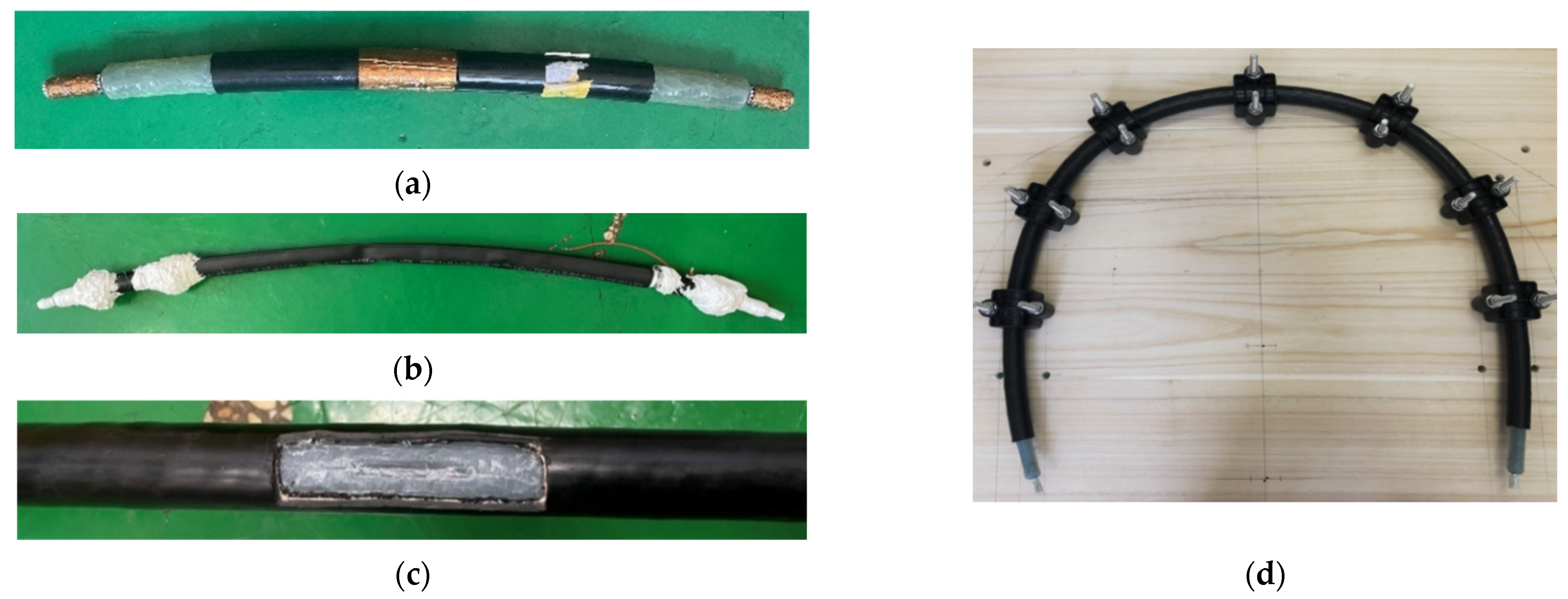
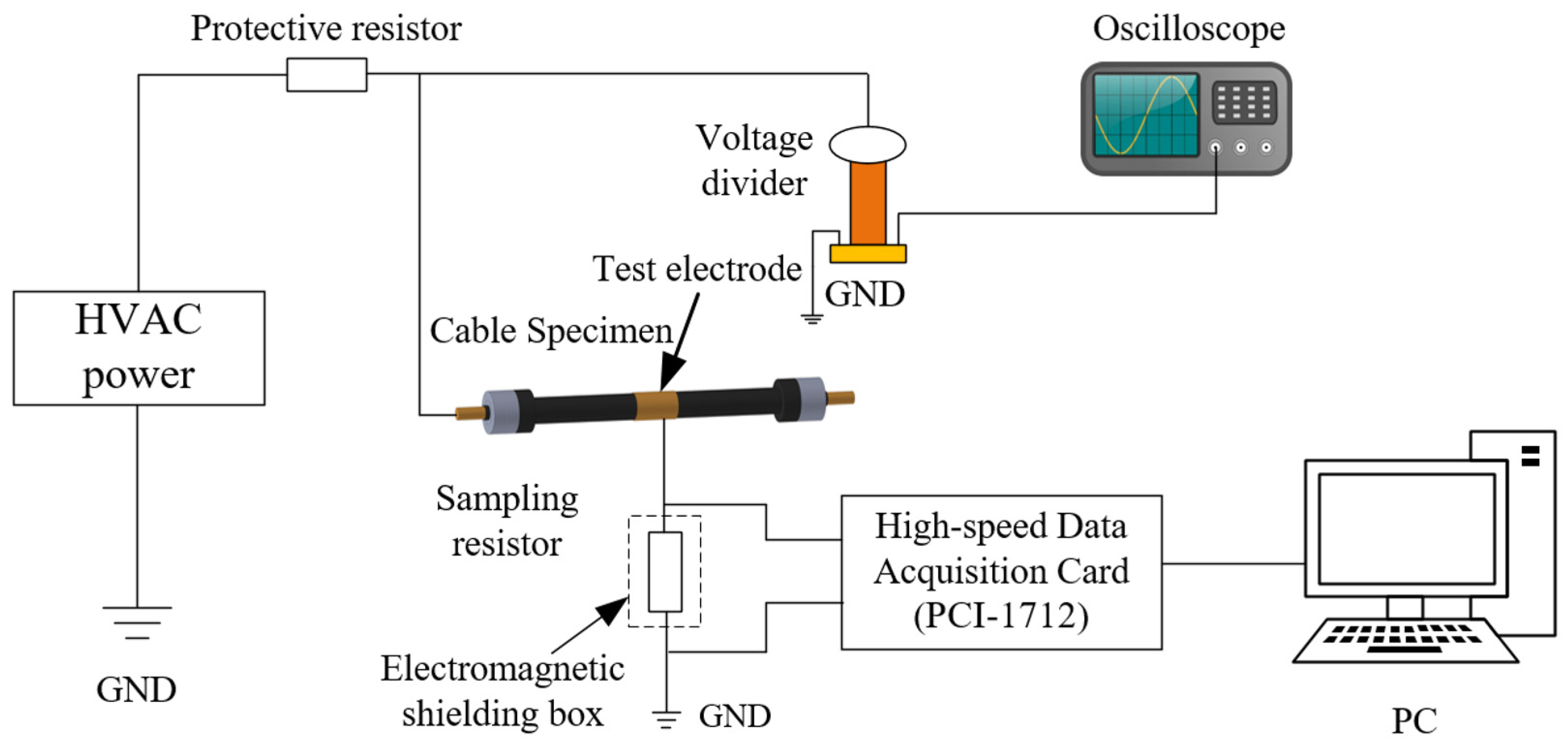
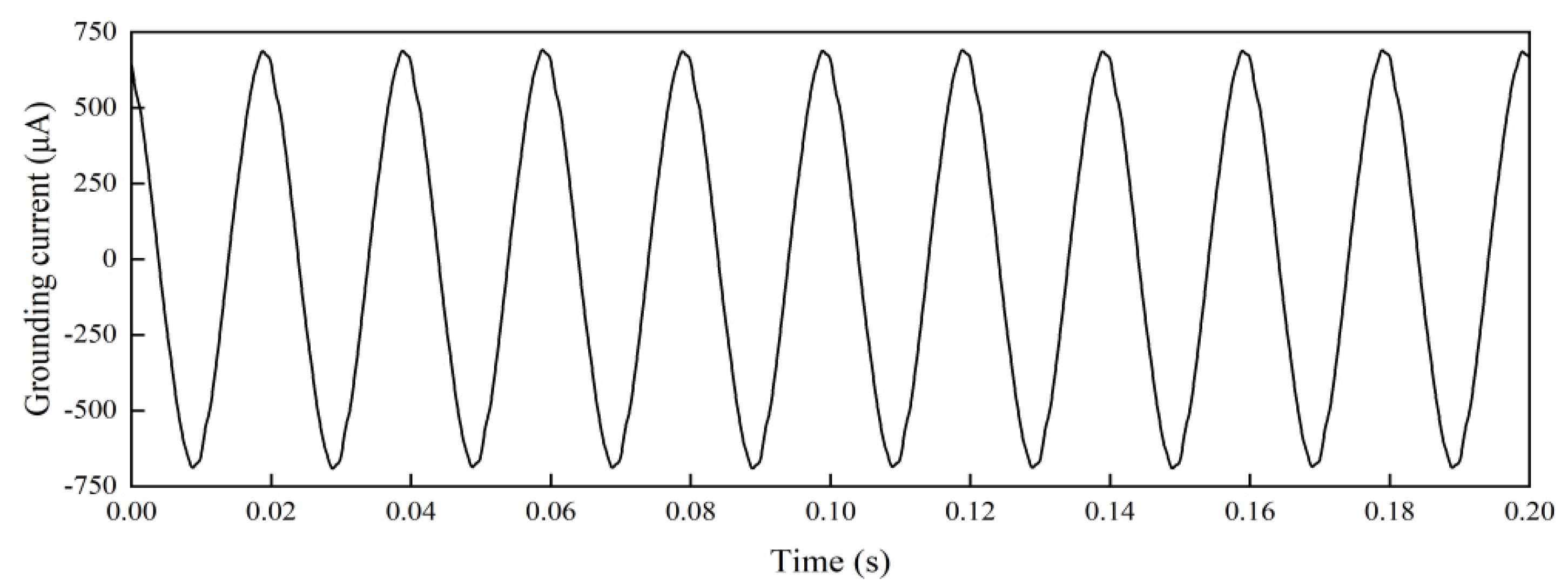

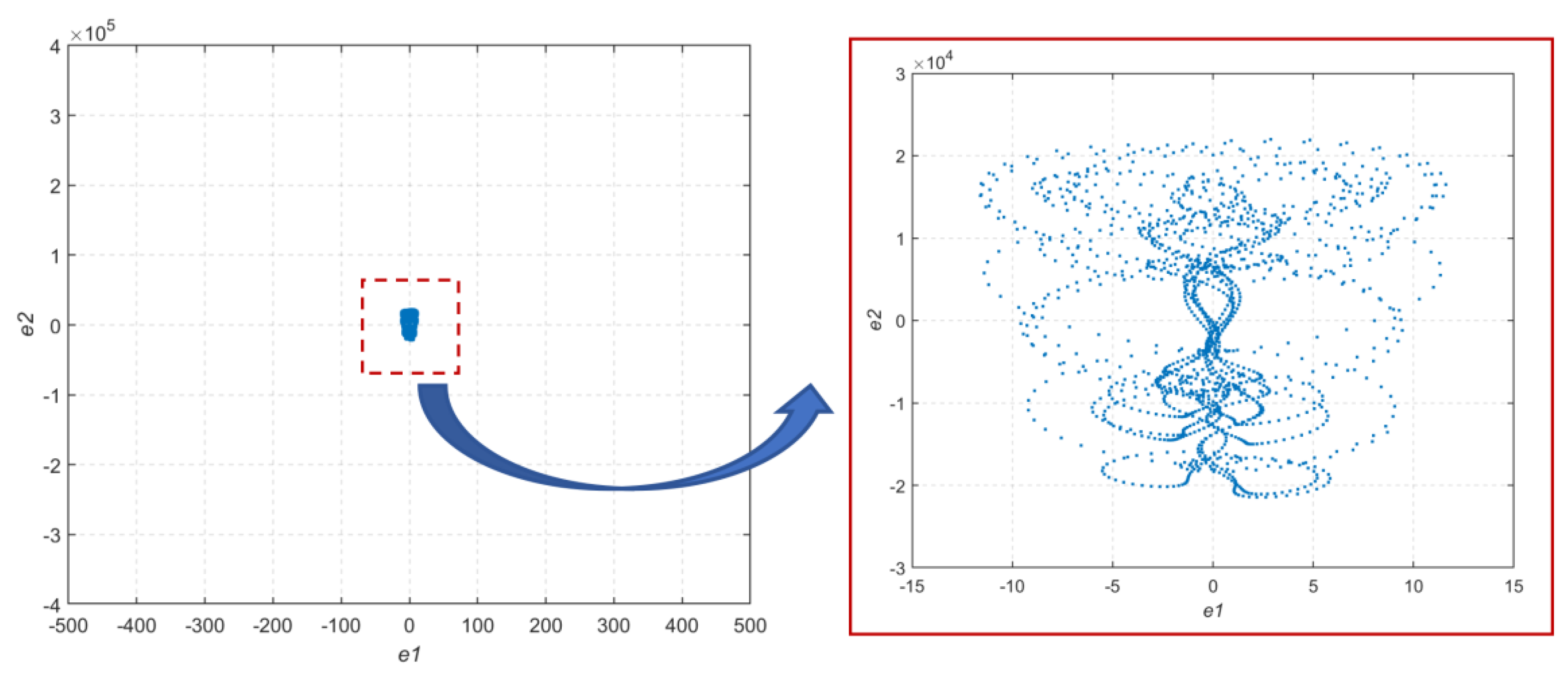

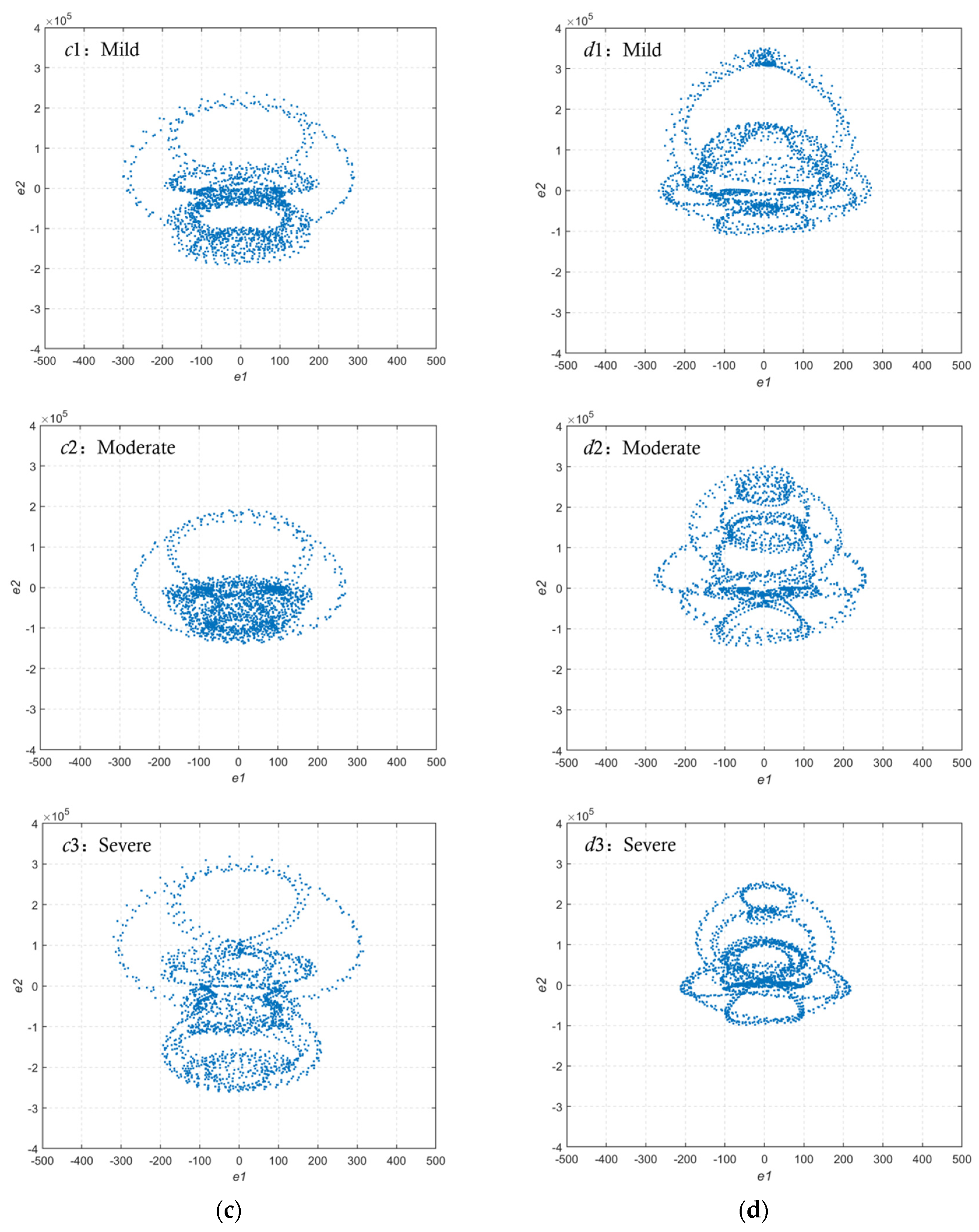
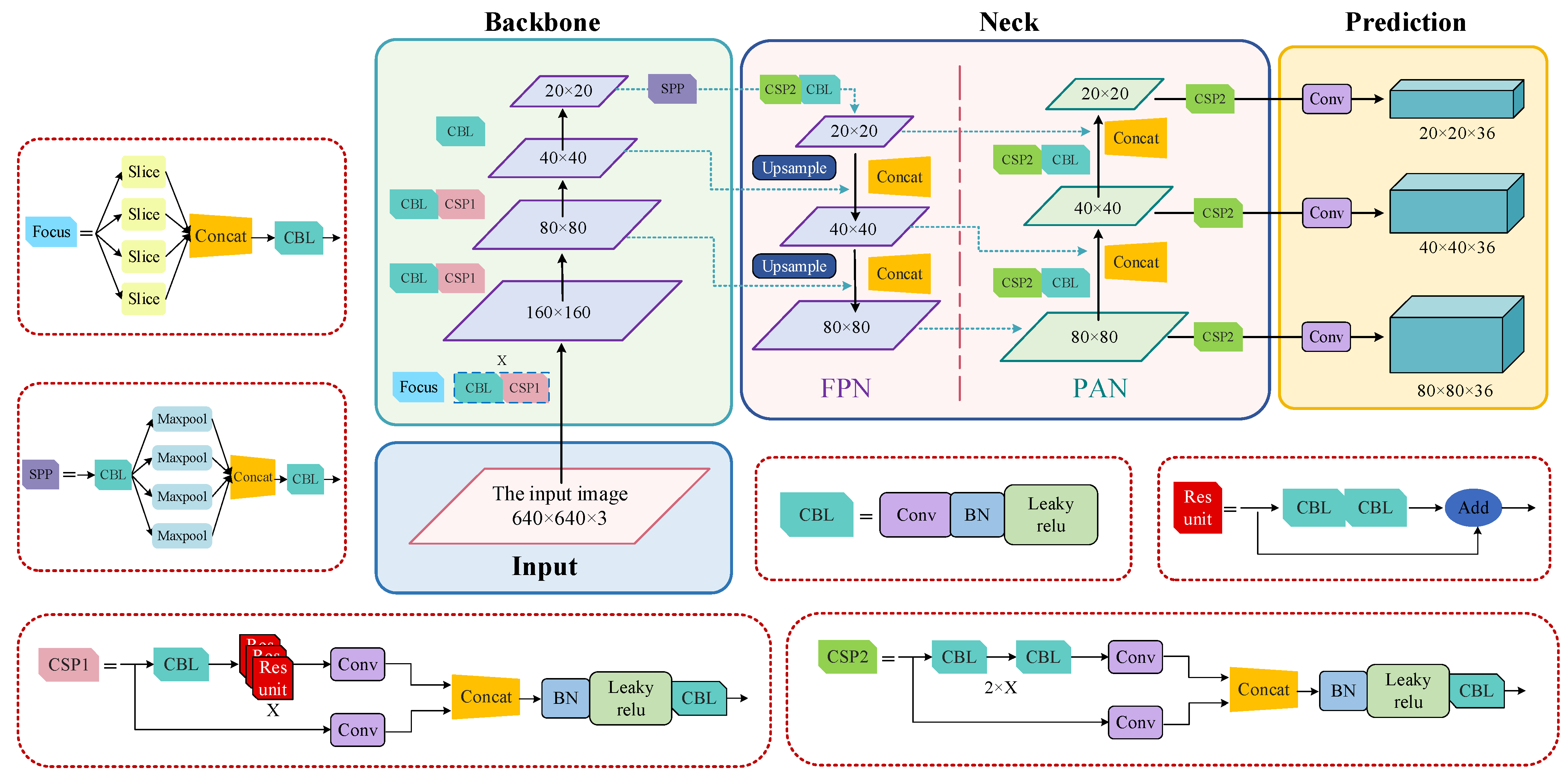

| Category | Version |
|---|---|
| Operating system | Windows 11 (64-bit) |
| CPU | Intel Core i7-12700H |
| GPU | NVIDIA GeForce RTX 3070 |
| RAM | 32 GB |
| Software | Python 3.10 |
| Defect Type | Test Quantity | Accurate Quantity | Identification Accuracy/% |
|---|---|---|---|
| Thermal aging | 45 | 44 | 96.67% |
| Water ingress and dampness | 45 | 41 | |
| Insulation scratch | 45 | 44 | |
| Excessive bending | 45 | 45 |
| Method | Harmonics Visualization + YOLOv5 | Multi-Feature Extraction + BPNN | |||||
|---|---|---|---|---|---|---|---|
| Model Establishment Procedure | Chaotic Synchronization System | YOLOv5 | Harmonics Separation | Multi-Feature Extraction | mRMR Feature Selection | PCA Feature Fusion | BPNN |
| Test Time/s | 1.23 | 0.33 | 0.42 | 0.51 | / | 0.75 | 0.86 |
| Identification Accuracy/% | 96.67% | 95.56% | |||||
Disclaimer/Publisher’s Note: The statements, opinions and data contained in all publications are solely those of the individual author(s) and contributor(s) and not of MDPI and/or the editor(s). MDPI and/or the editor(s) disclaim responsibility for any injury to people or property resulting from any ideas, methods, instructions or products referred to in the content. |
© 2024 by the authors. Licensee MDPI, Basel, Switzerland. This article is an open access article distributed under the terms and conditions of the Creative Commons Attribution (CC BY) license (https://creativecommons.org/licenses/by/4.0/).
Share and Cite
Wang, M.; Liu, Y.; Huang, Y.; Xin, Y.; Han, T.; Du, B. Defect Identification of XLPE Power Cable Using Harmonic Visualized Characteristics of Grounding Current. Electronics 2024, 13, 1159. https://doi.org/10.3390/electronics13061159
Wang M, Liu Y, Huang Y, Xin Y, Han T, Du B. Defect Identification of XLPE Power Cable Using Harmonic Visualized Characteristics of Grounding Current. Electronics. 2024; 13(6):1159. https://doi.org/10.3390/electronics13061159
Chicago/Turabian StyleWang, Minxin, Yong Liu, Youcong Huang, Yuepeng Xin, Tao Han, and Boxue Du. 2024. "Defect Identification of XLPE Power Cable Using Harmonic Visualized Characteristics of Grounding Current" Electronics 13, no. 6: 1159. https://doi.org/10.3390/electronics13061159
APA StyleWang, M., Liu, Y., Huang, Y., Xin, Y., Han, T., & Du, B. (2024). Defect Identification of XLPE Power Cable Using Harmonic Visualized Characteristics of Grounding Current. Electronics, 13(6), 1159. https://doi.org/10.3390/electronics13061159






